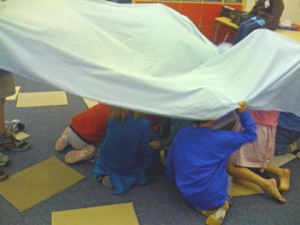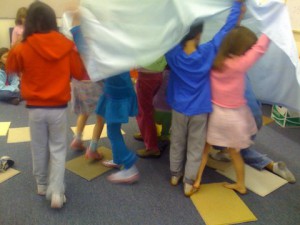This week, the Children’s Religious Education Committee and I wanted to give volunteer Sunday school teachers a break — it was Columbus Day weekend, which often means attendance goes down, which can be discouraging for teachers who plan a lesson only to have two or three kids show up — so I said I would lead a chapel service for all kids who showed up. And that’s what I did this past Sunday….
As usual, the children went in to the first fifteen minutes of the regular worship service. The first fifteen minutes of the worship service this week were particularly welcoming to elementary age children. Susan Owicki, this week’s worship associate, made sure to mention that one of the children in the family who lit the chalice was having her fourth birthday today (the children in that family had already come to Sunday school at 9:30 and left right after they lit the chalice). The guest musician was a folksinger, and he sang a song that many children know, “A Place in the Choir” by Bill Staines. And the first hymn was an easy-to-sing “zipper song,” an African American hymn titled “There Is More Love Somewhere.” I thought to myself, Too bad so few elementary-aged children came this week!
We gathered all the children together in Room 6. Like most of our Sunday school rooms here, it measures about 17 by 15 feet; allowing 25 square feet per child, that means the room will feel crowded with more than ten children. Originally, I had thought I would set up in Rooms 4 and 5, because there’s an accordion-type room divider between those two rooms that we can keep back, theoretically doubling the capacity. However, when I began to set up in that room I realized that because of the furniture left in that room by the day school who rents that space Monday through Friday, I would actually have less useful space and far more distractions in that room.
As the most space-efficient way to set up the room, I arranged carpet squares on the floor in concentric semi-circles, facing a wall with four adult-sized chairs. 21 children and 6 adults showed up for the chapel service. I thought to myself, Maybe it’s just as well that more children did not show up this week!
After I took attendance, we began by lighting the chalice. I asked the oldest child present, a sixth grader, to light the chalice for us, while the rest of us said the usual words together, with the usual hand motions (note to self: I really need to come up with some different words to say when we light the chalice). I asked the children why we made “U” signs with our hand when we said “Unitarian Universalist,” and they told me that one “U” stood for “Unitarian” and one “U” stood for “Universalist.” “And why do we touch our heads for the words ‘the church of the open mind’?” “We’re pointing to our minds!” “Cause we have open minds!” “And why do we hold out our hands…” “Cause we’re showing our helping hands!” “Yeah, we have helping hands!” “So why do we put our hands here [over our hearts] when we say ‘the church of the loving hearts’?” “Cause we have loving hearts!” “Cause that’s where your heart is!” The younger children paid close attention, but it seemed to me that it was mostly the older children who shouted out their explanations.
I had planned to sing two or three songs with the children, but the person who was going to play guitar for me was ill and couldn’t be there. Fortunately Dave, one of the adults present, said he could accompany us on guitar, so I invited him to come sit up front and gave him my guitar to use; he played while I taught the children the song we had sung in the worship service, “There Is More Love Somewhere.” We went over the words line by line, then I lined out the song, and finally we all sang the four verses together. The singing was a little ragged at first, but by the end of the song everyone was singing fairly confidently — not confidently enough that I quite dared sing a harmony part over or under the melody, but confidently enough to sound pretty good.
The children were feeling pretty squirmy, so I told them to all stand up, and we did ten jumping jacks together. Then we sat down, and I read them the story “The Quails and the Net.” Then we acted out the story together. J—- acted the part of Buddha, and she came down front to sit in full lotus position on one of the chairs next to me. She had three disciples, or followers (all children in 3rd to 5th grades), who argued, and so she told them the story of the quails and the net.
N—-, who is in 5th grade, knew how to make a quail-like sound by blowing into his cupped hands, so he became the hunter; E—-, who is in 6th grade, was another hunter. Edie, one of the adults, came up with a sheet to use as the net (usually I don’t include props when I have children act out a story, but the sheet made a perfect net, and was a good prop to use). E—-, who is confident but also one of the younger children who was there, wanted to be the bush that the hunter hid behind. L— was the thorn bush. The rest of the children, who were mostly younger children (with a couple of older children who provided something of a steadying influence) were the quails.
Heather, one of the adults present, thought to bring her camera, and she documented the story as the children acted it out. I don’t put photographs on my Web site in which children are recognizable (for all the obvious reasons), but here are a couple of photos in which you can’t recognize children to give you an idea of how photographs can document the story:

Here’s the net being thrown over the scurrying quails.
Here are the quails flying up together, just about to deposit the net in the sharp thorns of the rose bush. (In the background at far left, you can just see bits of Buddha and one of the disciples watching the story unfold in front of them.)
These two photos will give you a little idea of what the story looks like as the children act it out.
When we had finished acting out the story of the quails and the net, the Buddha wanted to read aloud her final statement to her followers, so I gave her my story script to read from: “When you were on this earth as quails, you argued among yourselves, and were caught by the hunter, and were eaten fro dinner that very night. You are no longer quails. Is it not time for you to stop arguing among yourselves?”
We had a very brief discussion about what this story might mean. It was not a particularly good discussion, partly because we had so many younger children (grades K-2) who could not be expected to do much more than repeat the most obvious moral to the story, and partly because the children could see that people were coming out of the worship service. But I didn’t care if we didn’t have a good discussion — mostly, I wanted to model for the children that it is possible to think about stories and try to discover what they mean.
We had a quick closing circle, I told the children that I hoped to see them again next week, and then it was time to go.
I printed out some of the photographs from the story, and when I have time I will put together a bulletin board display, interspersing photos with the story.
Comments
(a) This chapel service doesn’t look all that different from the Sunday school classes I’ve been teaching. Partly this is because I try to make my Sunday school classes feel more like worship than like school. But partly this is also because of the space I am forced to use to do chapel services — you can do a great deal towards creating a worshipful mood with a dignified, attractive space.
Queries for the reader
(1) What do you do when children are particularly squirmy? Would you be more likely to lead them in some jumping jacks, or to tell them to sit still and then enforce your verbal commands? How much squirming will you tolerate in Sunday school?
(2) Having children act out a story can engage visual learners, verbal learners, and kinesthetic learners equally well. What other teaching techniques (or worship-leading techniques) do you use that engage all three learning types?

